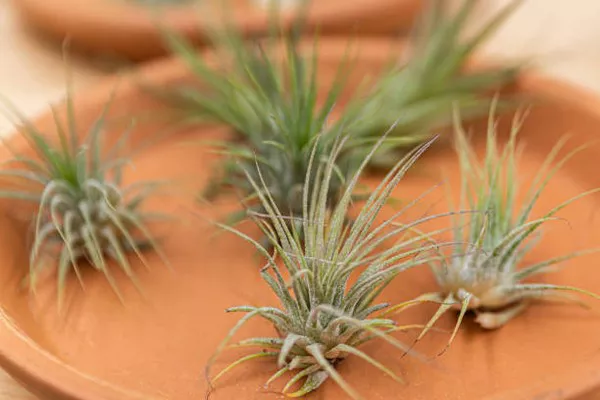Growing air plants (Tillandsia) can be a rewarding endeavor, whether you choose to propagate them from seeds or pups. While propagating air plants from pups is often the simpler route, growing them from seeds can yield stronger plants and offer a fascinating gardening experience. In this article, we will guide you through the process of pollinating air plants to obtain seeds, unlocking a new dimension of air plant cultivation.
Understanding Air Plant Reproduction
Air plants have two primary methods of reproduction: producing seeds and forming pups. Pups are small offshoots that develop on the sides of the parent plant. Typically, it takes several years for a pup to reach reproductive maturity, and at this stage, the parent air plant will bloom, a once-in-a-lifetime event.
After blooming, the parent air plant will begin producing pups, also known as offsets. Usually, one air plant will produce between one to four pups, although this number can increase over time. Once these pups reach at least half the size of the parent plant, they can be separated and grown independently. However, if you’re keen on obtaining seeds from your air plant, pollination is the key.
The Importance of Pollination
Without pollination, your air plant will solely produce pups. Subsequently, the flower will eventually wither, which may take a few weeks or even up to a year in some cases. As the parent air plant declines, the pups will cluster around it, forming a clump.
Many Tillandsias naturally bloom during dry periods of the year, followed by seed development. These seeds are released from bursting seed pods and land on cliffs and branches, where they have an optimal chance of germination. This process occurs before the rainy season to prevent the seeds from being washed away by rain.
Pollinating Air Plants
If your goal is to obtain seeds from your blooming air plants, you’re on the right track. Given that air plants bloom infrequently, and most blooms last only a few weeks, time is of the essence. If your Tillandsia has already bloomed or is currently in bloom, you can prepare for pollination.
The bloom of an air plant is called an inflorescence, comprising a bract (a modified leaf from which the flower emerges and contains the reproductive structures), stem, stalk, and the primary blossom.
While most air plants are capable of self-pollination, some may not be. Nonetheless, attempting self-pollination is always an option. After pollination is successful, the flower will wither, and you’ll notice darkening in that spot, indicating seed pod formation. These seed pods will be elongated and enclosed, housing the seeds.
Once the seeds are mature, the pods will burst open, releasing seeds with fluffy hairs, often referred to as parachutes or coma. These fluffy structures aid in wind dispersal in their natural habitat. The time it takes for the seed pods to open varies but typically ranges from a few months to as long as 10-12 months. Once the pods burst, you can collect the seeds and prepare for germination.
Cross-Pollination of Air Plants
If you have two different types of air plants and wish to create a hybrid, you can attempt cross-pollination, a practice known as selective breeding. While it’s exciting to create hybrids with unique characteristics, it’s also essential to preserve the original species. Cross-pollination can yield beautiful hybrids, especially when combining air plants with attractive colors and distinctive traits.
To cross-pollinate air plants, you’ll need to transfer pollen from one air plant to another’s female reproductive part, known as the stigma. There are many known air plant hybrids, and experimenting with your own combinations can be rewarding.
Some examples of beautiful air plant hybrids include:
Tillandsia Cotton Candy in bloom
Tillandsia stricta x T. paucifolia
T. usneoides x Tillandsia recurvata (famous T. Kimberly)
Tillandsia arhiza-juliae x T. pruinosa
Tillandsia stricta x Tillandsia recurvifolia (famous T. Houston)
T. Streptophylla x T. Concolor (famous T. Redy)
T. brachycaulos x T. streptophylla (called T. Eric Knobloch
T. Houston Cotton Candy – Tillandsia Stricta x Tillandsia Recurvifolia
Pollination Techniques
When pollinating your air plant, time is crucial, as air plant flowers have a short lifespan. Once the flower has opened, you can initiate the pollination process. To pollinate your air plant, use a small, soft bristle brush or a q-tip to gently transfer pollen from the stamen (male part) to the female stalk. You can perform self-pollination by transferring pollen within the same flower or cross-pollinate by moving pollen from one flower to another air plant’s female stalk. It’s essential to document your actions to keep track of which plants you have pollinated or cross-pollinated.
Harvesting Air Plant Seeds
After pollinating your air plant, be prepared to wait, as it can take anywhere from 2-3 months,or sometimes up to 10 months, for the seed pods to mature and burst open. The pods are typically elongated and brown in color. Once they burst, you’ll see seeds being released. Carefully collect these seeds with tweezers for immediate germination (more details on germination in another post).
To prevent the loss of seeds, especially if you are a meticulous observer, consider wrapping your air plant’s pods with a thin gauze or cheesecloth. These air plant seeds are designed for easy wind dispersal, increasing their chances of germination.
You can share your air plant seeds with friends and family, as a single plant can produce an abundance of seeds. If you wish to store the seeds, keep them in a refrigerator for 1-2 months, but remember to germinate them within that time frame. Sow air plant seeds within a week of collection to ensure viability.
In conclusion, mastering the art of air plant pollination opens the door to a world of botanical possibilities. Whether you aim to obtain seeds for a future generation of air plants or experiment with creating unique hybrids, the careful process of pollination is a fascinating aspect of air plant cultivation. With patience and diligence, you can enjoy the rewards of your efforts in the form of thriving air plant offspring.


